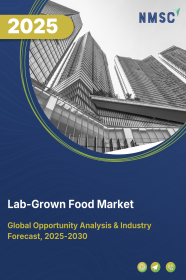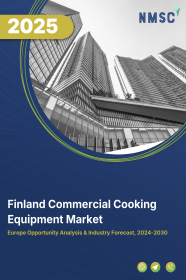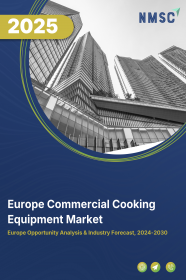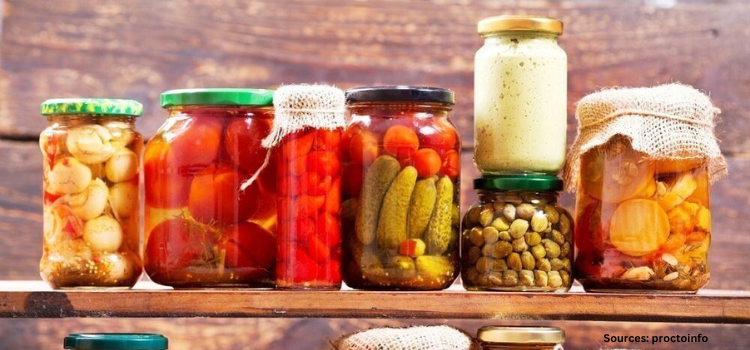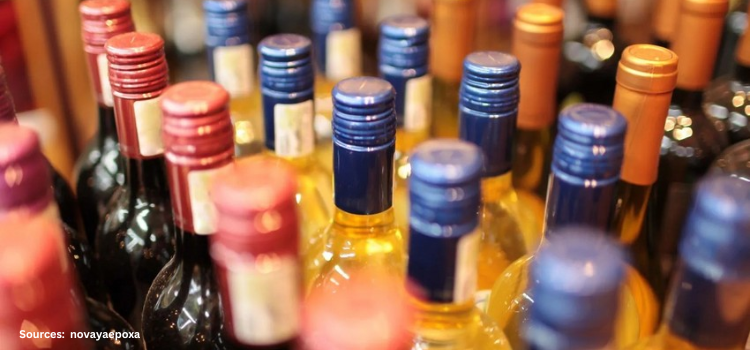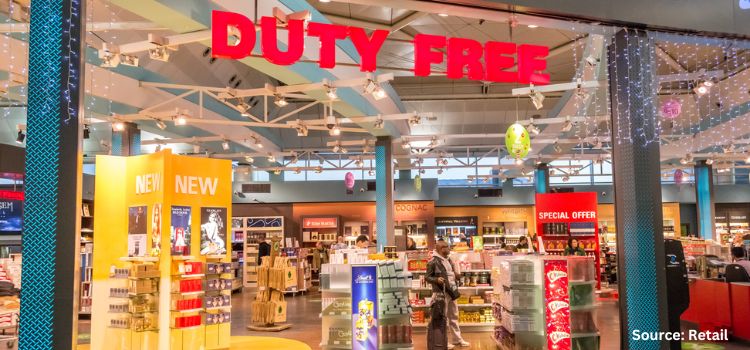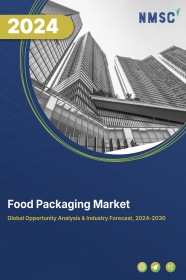
Food Packaging Market by Material (Plastic, Metal, Glass, and Paper & Paperboard), by Packaging (Rigid, Semi-Rigid, and Flexible), by Product (Cans, Converted Roll Stock, Gusseted Box, Boxboard, and Specialty Packaging), and by Application (Bakery & Confectionery, Dairy Products, Poultry & Meat Products, Fruits & Vegetables, and Others) – Global Opportunity Analysis and Industry Forecast 2024-2030
US Tariff Impact on Food Packaging Market
Trump Tariffs Are Reshaping Global Business
Market Definition
The global Food Packaging Market was valued at USD 392.93 in 2023 and is predicted to reach USD 565.13 billion by 2030 with a CAGR of 5.3% from 2024-2030.
The food packaging industry includes the production, design, and distribution of packaging materials and solutions specifically tailored for the protection and presentation of food products throughout the supply chain. This includes using diverse range of materials such as plastics, paper, metals, and glass, and food packaging to serve multiple crucial functions, including preserving food freshness, extending shelf life, preventing contamination, and facilitating transportation and storage.
This industry offers a wide array of packaging formats, including bags, pouches, bottles, cans, cartons, trays, and boxes, each designed to meet the unique requirements of different food types and packaging needs.
In addition to its functional roles, food packaging serves as a vehicle for branding, marketing, and consumer communication, with packaging designs, labeling, and promotional messages aimed at attracting consumers and enhancing brand recognition. Compliance with stringent regulatory standards governing food safety, labeling, and packaging materials is paramount in the food packaging industry to ensure consumer safety and maintain product integrity.
Furthermore, there's a growing emphasis on sustainability within the industry, with a focus on developing eco-friendly packaging solutions and adopting waste reduction initiatives to minimize environmental impact and promote a circular economy approach to packaging materials.
Market Dynamics and Trends
The increasing preference for hygiene and sterile packaging solutions for food products, coupled with heightened efforts to preserve food quality through technology-driven packaging methods including modified atmospheric packaging (MAP), flatmap packaging, and vacuum atmospheric packaging, stands as the primary driver propelling growth in the food packaging market.
In 2023, ProAmpac introduced its fiber-based MAP RAP Sandwich Wedge, combining sustainability with extended shelf-life and enhanced branding for sandwiches and wraps in the North American market. Moreover, the significant consumption of processed food surges the demand for edible food packaging within the food packaging industry.
As it is utilized for wrapping or coating around food to minimize waste and does not necessitate recycling. As per Northeastern University's Network Science Institute, it was found that 73% of the U.S. food supply is ultra-processed.
In addition, the rising e-commerce and online grocery shopping platforms has created new opportunities and challenges for the food packaging industry. As online shopping continues to grow the demand for packaging solutions tailored to the unique requirements of e-commerce. According to the report published by Shopify, the global e-commerce industry size is expected to reach USD 58,740 billion by 2028, with a CAGR of 26.5%.
However, the stringent regulations governing food safety, labeling, and packaging materials poses challenges for packaging manufacturers, requiring costly compliance measures and limiting flexibility in packaging design and materials.
As an example, the Chinese local Ministry of Agriculture and Rural Affairs (MARA) launched a draft containing formalized proposed standards to govern excessive packaging, with an initial focus on fruit, meat, egg, and seafood products.
On the contrary, increasing consumer awareness of environmental issues compels companies to develop eco-friendly packaging materials, such as biodegradable plastics, compostable packaging, and recyclable materials, to meet consumer preferences and reduce environmental impact.
Thus, it is expected to create ample growth opportunities for the market in the coming years. For example, SEE introduced CRYOVAC brand Barrier Formable Paper to reduce plastic usage, potentially disrupting traditional packaging dynamics and attracting businesses focusing on sustainability in the food industry for broader adoption of sustainable packaging solutions.
Market Segmentations and Scope of the Study
The food packaging market is segmented based on material, packaging, product, application, and region. Based on materials, the market is divided into plastic, metal, glass, and paper & paperboard. Based on product, the market is classified into cans, converted roll stock, gusseted box, boxboard, and specialty packaging.
Based on packaging, the market is categorized into rigid, semi-rigid, and flexible. Based on application, the market is divided into bakery & confectionery, dairy products, poultry & meat products, fruits & vegetables, and others. Regional breakdown and analysis of each of the aforesaid segments include regions comprising North America, Europe, Asia-Pacific, and Rest of the World (RoW).
Geographical Analysis
The Asia-Pacific region holds the predominating share in food packaging at present and is expected to continue dominating the market during the forecasted period. Factors such as the rising use of recycled materials for the food packaging process propels the growth of the market.
In 2023, Mars Wrigley China launched its first 100% recycled PET (rPET) packaging through the local brand Cui Xiang Mi (CXM), marking a significant leap in sustainable packaging practices and commitment to a circular economy.
Moreover, the increasing consumer demand for sustainable products drives the adoption of biodegradable food packaging in response to environmental concerns and regulatory initiatives. In 2022, Defence Research and Development Organisation (DRDO) introduced biodegradable packaging solutions as sustainable alternatives to single-use plastics, offering bags that degrade within three months, crafted from natural, plant-based materials in collaboration with Acharya Nagarjuna University and Ecolastic Private Limited, aiming to combat plastic usage and promote environmental responsibility.
On the other hand, the North American food packaging market is experiencing consistent growth driven by increasing demand for processed food products in the region. In 2023, the U.S. exported processed food items worth USD 12.11 billion to Canada, with Mexico following closely behind at USD 5.86 billion, as reported by the U.S. Department of Agriculture (USDA).
Moreover, the introduction of recyclable food packaging products by the regional companies thrives the growth of the market across the region. For instance, Novolex introduced food packaging containers with a minimum of 10% post-consumer recycled content, manufactured by Waddington North America (WNA), aligning with Novolex's commitment to environmental responsibility and innovation.
Competitive Landscape
The major market players in food packaging industry are Amcor plc, Tetra Pak International S.A., Berry Global Group, Inc., Sealed Air Corporation, Ball Corporation, Mondi plc, DS Smith plc, Huhtamäki Oyj, Sonoco Products Company, and Crown Holdings, Inc., among others.
These market players continue to adopt various market development strategies including joint venture, product launch, and investment across various regions to maintain their dominance in the food packaging market.
For instance, in December 2023, Tetra Pak introduced a proactive strategy aimed at transforming food systems, emphasizing practical actions to drive change. This initiative focuses on fostering sustainable and resilient food systems by leveraging an integrated approach.
Also, in June 2023, Mondi collaborated with Syntegon to create sustainable food paper packaging using recycled content, tailored for dried foods like flour, sugar, and pasta, aiming to meet rising consumer demand for eco-friendly packaging while prioritizing resource efficiency and recyclability.
Moreover, in May 2023, Berry Global, Peel Plastics, and ExxonMobil collaborated to incorporate certified-circular content into pet food packaging, using advanced recycling technology to promote sustainability and environmental responsibility.
In addition, in February 2023, Amcor invested USD 250,000 into a smart reusable food packaging start-up circulation that aims to reduce plastic usage and promote eco-friendly practices, setting a new standard for sustainable packaging.
Key Benefits
-
The food packaging market report provides a quantitative analysis of the current market and estimations from 2024 to 2030. This analysis assists in identifying the prevailing market opportunities to capitalize on.
-
The study comprises of a detailed analysis of the current and future food packaging market trends, depicting the prevalent investment pockets in the market.
-
The information related to key drivers, restraints, and opportunities and their impact on the food packaging market is provided in the report.
-
The competitive analysis of the market players along with their market share in the food packaging market is mentioned.
-
The SWOT analysis and Porter’s Five Forces model are elaborated in the study.
-
The value chain analysis in the market study provides a clear picture of the stakeholders’ roles.
Food Packaging Market Key Segments
By Material
-
Plastic
-
Metal
-
Glass
-
Paper & Paperboard
By Type
-
Rigid
-
Semi-Rigid
-
Flexible
By Product
-
Cans
-
Converted Roll Stock
-
Gusseted Box
-
Boxboard
-
Specialty Packaging
By Application
-
Bakery & Confectionery
-
Dairy Products
-
Poultry & Meat Products
-
Fruits & Vegetables
-
Others
By Region
-
North America
-
The U.S.
-
Canada
-
Mexico
-
-
Europe
-
The UK
-
Germany
-
France
-
Italy
-
Spain
-
Denmark
-
Netherlands
-
Finland
-
Sweden
-
Norway
-
Russia
-
Rest of Europe
-
-
Asia-Pacific
-
China
-
Japan
-
India
-
South Korea
-
Australia
-
Indonesia
-
Singapore
-
Taiwan
-
Thailand
-
Rest of Asia-Pacific
-
-
RoW
-
Latin America
-
Middle East
-
Africa
-
REPORT SCOPE AND SEGMENTATION:
|
Parameters |
Details |
|
Market Size in 2023 |
USD 392.93 Billion |
|
Revenue Forecast in 2030 |
USD 565.13 Billion |
|
Growth Rate |
CAGR of 5.3% from 2024 to 2030 |
|
Analysis Period |
2023–2030 |
|
Base Year Considered |
2023 |
|
Forecast Period |
2024–2030 |
|
Market Size Estimation |
Billion (USD) |
|
Growth Factors |
|
|
Countries Covered |
28 |
|
Companies Profiled |
10 |
|
Market Share |
Available for 10 companies |
|
Customization Scope |
Free customization (equivalent up to 80 working hours of analysts) after purchase. Addition or alteration to country, regional, and segment scope. |
|
Pricing and Purchase Options |
Avail customized purchase options to meet your exact research needs. |
KEY PLAYERS
-
Amcor plc
-
Tetra Pak International S.A.
-
Berry Global Group Inc.
-
Sealed Air Corporation
-
Ball Corporation
-
Mondi plc
-
DS Smith plc
-
Huhtamäki Oyj
-
Sonoco Products Company
-
Crown Holdings Inc.

















 Speak to Our Analyst
Speak to Our Analyst



